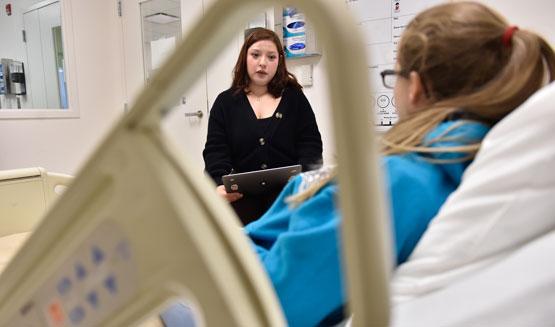news
Navigating health care
When you think of the top terms for health care providers, physicians and nurses immediately come to mind. However, in the ever-evolving world of health care, there’s a role that’s growing both in need and importance: patient navigator.

“It’s a relatively new profession, one that got its start through the American Cancer Society (ACS),” said Dr. Nina Cleveland, assistant professor of health science and Health Sciences department chair for Georgia Gwinnett College (GGC).
GGC’s patient navigation program is one of only a handful available in the country, and one of only two at the bachelor degree level. Since its launch in 2021, the program has grown from 24 to 276 students.
For Eduardo Montero, a Lawrenceville native who will graduate from GGC in May with his bachelor’s degree in health science with a patient navigation concentration, the field garnered his attention.
“I was looking on the GGC website in health care to see what options I would have,” he said. “I wanted a career in health care, but not in the clinical aspect of it. When I saw the option for patient navigation, I knew that’s what I wanted to do.”
The idea of a patient navigator came from an ACS presentation in 1989, “Report to the Nation on Cancer in the Poor,” which then led to a pilot program in1990 at Harlem Hospital in New York. By removing barriers that included financial, access, information, medical system and emotional barriers, patients could receive timely care for prevention, detection, diagnosis, treatment and improved survivorship.
“Having a patient navigator to assist people with chronic or complicated health issues has helped improve outcomes,” said Cleveland. “There’s a growing need for patient-centered care.”
According to the Bureau of Labor Statistics (BLS), the demand for patient navigators is projected to grow 14% by 2032.
Being a patient navigator does involve paperwork and critical thinking skills, but Montero learned that there is more to it.
“I learned it’s a lot more emotional than that. The health care system is tough to navigate, and people don’t always advocate for themselves,” Montero said. “While I was working in health clinics, I realized there are people at risk for things like diabetes, hypertension and poor nutrition, and don’t know to get help or how to get it.”
Montero quickly learned that speaking in a compassionate, yet straightforward manner is best. He added that being bilingual has also been a bonus.
“You can build trust that way, so that patients can get the resources they need,” he said. “They will then tell family and friends about their experience.”
The program is designed to prepare students to take multiple paths.
“The first two years are the same prerequisite coursework as nursing students,” said Cleveland. “Once they complete those two years, students can begin coursework for the patient navigation path. After graduation, they are ready to pursue a career as a patient navigator or other careers in health care. Some students choose to pursue a master’s program of their choice.”
Montero added that with his degree, he’ll have the flexibility to travel and work and then pursue a master’s degree.
View and download health science, patient navigator gallery photos.
